
Are long eyelashes a genetic trait?
November 29, 2018

- Related Topics:
- Punnett squares,
- Medical genetics,
- Autosomal recessive inheritance,
- Complex traits
A high school student from Australia asks:
"Are long eyelashes a genetic trait?"
In some cases, yes! Eyelash length definitely is influenced by genetics, but there are other factors that can affect it too.
I couldn’t find much about how genetics affects normal eyelash variation. If your eyelashes are slightly longer or shorter than average, we don’t have a good explanation for how that happens. Maybe someday we’ll know more about how our genes affect this trait!
But there is information about a condition called trichomegaly. This is just a fancy word for super long eyelashes, defined as longer than 12mm in length. So for the rest of this article, I’ll focus on that.
Born with Trichomegaly
Eyelash trichomegaly can have several different causes. These causes can include both genetic inheritance and environmental causes (such as side effects of certain drugs).
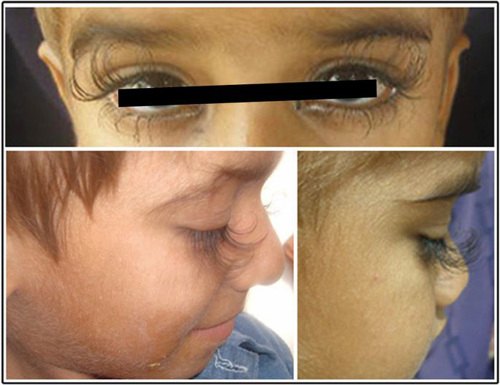
There are a few ways to be born with long eyelashes.
Sometimes trichomegaly occurs as part of a congenital disorder or syndrome. These are conditions that are present from birth, either due to genetics or otherwise.
Oliver-Mcfarlane syndrome and Cornelia de Lange syndrome both lead to very long eyelashes. But they also have a lot of other symptoms! Oliver-Mcfarlane syndrome leads to defects in the eye and severe hormone deficiencies. Cornelia de Lange syndrome also causes growth defects and facial deformities.
Both of these syndromes have more symptoms than just long lashes. There are only a few known instances of being born with just super long eyelashes. It’s actually a pretty rare trait!
What causes trichomegaly in families?
While it’s rare to have super long lashes with no other symptoms, it does happen.
To better understand the genetics of long lashes, scientists decided to look at familial trichomegaly. In other words, they looked where long lashes ran in families.
Scientists compared DNA from family members with long eyelashes to their relatives with short eyelashes. When they did this, they found that family members with trichomegaly had mutations in a gene called FGF5.
What is FGF5 and what does it do?
FGF5 stands for “fibroblast growth factor 5.” This gene makes a protein responsible for blocking extra hair growth. The name of this protein? Also “fibroblast growth factor 5”! To avoid name confusion, I’ll just refer to it as “the protein”.
If the FGF5 gene gets mutated, it can’t make its protein. And if the protein isn’t around, your hair just keeps growing!
Everyone has two copies of the FGF5 gene: one from mom and one from dad. And in most people, these two copies of FGF5 are hard at work making their protein. This protein blocks extra hair growth, leading to normal eyelashes.
If you have two mutated, “broken” versions of the FGF5 gene, you won’t be able to make the protein. There’s nothing to tell your hairs to stop growing. You’ll have trichomegaly!
But what happens if you have one mutated version of FGF5 and one regular version? In this case, the mutated version doesn’t make any protein. But the second, non-mutated version will still make protein. And it turns out that just having one working version of FGF5 gives you enough protein to block extra hair.
This makes trichomegaly a recessive trait. Both copies of the gene need to be affected to see long lashes.
How is Eyelash Trichomegaly inherited?
How does someone inherit two mutated copies of FGF5? The only way this can happen is if you get one mutated version of FGF5 from each parent.
We can make use of a Punnett square to visually represent how the inheritance works. A Punnett square is a diagram scientists use to predict the outcome of a genetic cross.
In a Punnett square, a gene is typically represented by a letter. We can represent FGF5 by the letter F. Since each gene has two copies, we can say that an uppercase “F” represents a non-mutated copy of FGF5, and a lower-case “f” represents a mutated copy of FGF5.
Let’s use a Punnett square to see what happens when both parents have trichomegaly.
We start by drawing a square. On one side of the square, we’ll write Mom’s versions of FGF5. Remember, you need two mutated copies of FGF5 to have trichomegaly. Since she has trichomegaly, we know she has two broken FGF5 genes. We’ll write both in lowercase: “ff”.
Dad has trichomegaly as well, so both copies of his FGF5 gene will also be “f” and “f”. We’ll write those on the other side of the square.
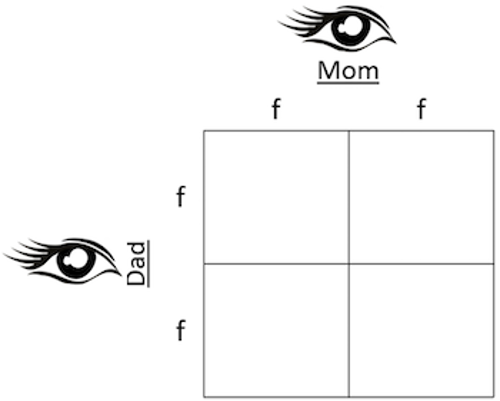
A Punnett square is split into four smaller squares. Each small square represents a possible combination that a child may receive.
In this case, since both parents only have mutated copies of FGF5, the only versions they can pass on are “f” and “f”. We’ll fill that in across the square.
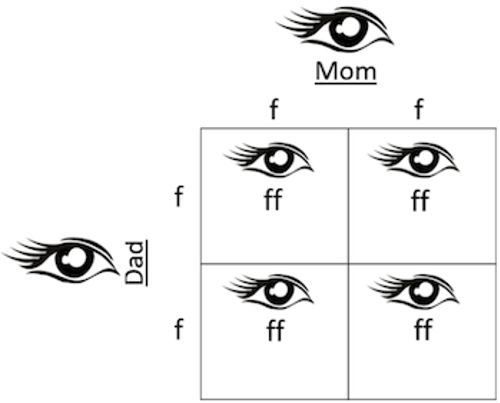
Since all children from this cross can only receive mutated copies of FGF5, they will not be able to produce the protein needed to block hair growth. They will all have trichomegaly.
What if only one parent has trichomegaly? Will their children have long eyelashes?
In some cases, yes! Let’s see how that could be possible.
Let’s say Dad has trichomegaly. In this case, we know that he has two mutated copies of FGF5. He is “ff”.
But let’s say Mom doesn’t have trichomegaly. Could she still pass on a mutated version of FGF5?
This is possible if she is a carrier of the FGF5 mutation. Remember, one working copy of FGF5 is enough to produce the protein needed to block hair growth. Mom could have one broken version and not know it! She could have one broken FGF5 gene (“f”) and one working version (“F”).
Let’s fill in a Punnett Square for their children.
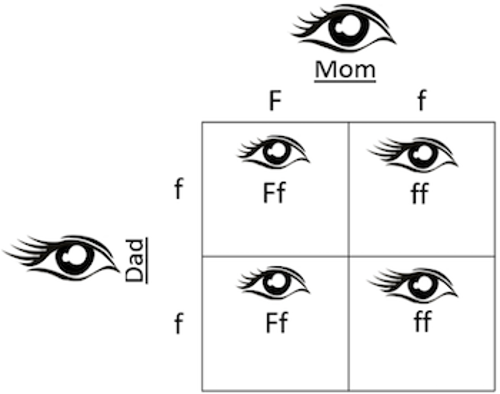
Half the children in this family will have trichomegaly.
In the study that the scientists conducted to figure out what gene was linked to trichomegaly, this was the type of scenario seen most often. There were many families where one parent had trichomegaly and the other did not, resulting in some children with trichomegaly and others without it.
What if neither parent has trichomegaly? Could they still have children with long eyelashes?
Yes! It’s possible to have a recessive trait pop up seemingly from nowhere. This can happen if both parents have one broken FGF5 gene (“f”) and one working version (“F”).
These parents do not have trichomegaly, but they can still pass on their single mutated copies of FGF5 to their children. They are carriers of the FGF5 mutation.
The Punnett square for this cross would look like this.
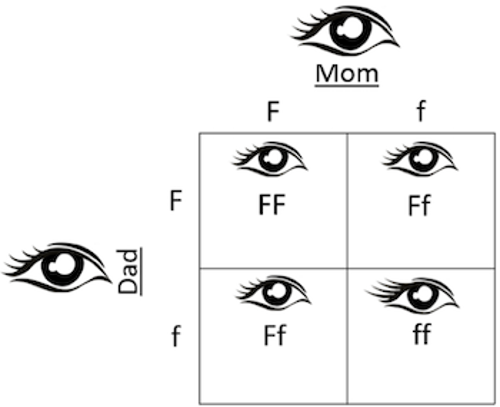
In this scenario, there is a 25% chance that a child from these parents will have trichomegaly.
Trichomegaly caused by certain drugs
It’s not just genetics that can cause long eyelashes -- certain drugs can too!
A drug known as latanoprost, which is used to treat glaucoma, can increase eyelash length. Latanoprost stimulates hair follicle cells, prolonging their growth phase and increasing lash length.
Erlotinib, a drug used to treat lung cancer, has also been shown to cause trichomegaly. It also seems to stimulate hair follicles, leading to abnormal hair growth.
As you can see, trichomegaly can have several different causes, some genetic and some non-genetic.

Author: Harmony Folse
When this answer was published in 2018, Harmony was a Ph.D. candidate in the Department of Genetics, studying fruit fly reproductive development and gene expression in both Joseph Lipsick's and Margaret Fuller's laboratories. As of 2020, they are teaching Biology as an adjunct instructor at various community colleges in the Bay Area.
 Skip Navigation
Skip Navigation
